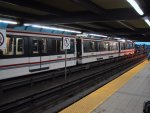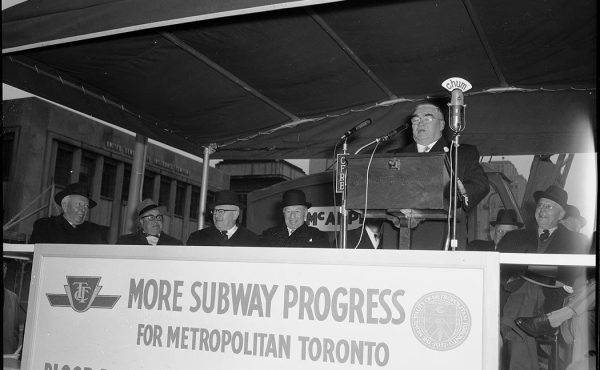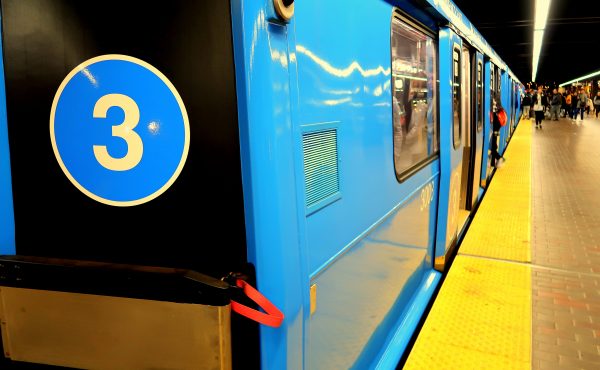Photo by Calum Tsang. Crossposted to Transit Toronto.
Scarborough residents won’t receive the full presentation until later tonight, but the Toronto Star received details of some of what consultants recommend could be done with the aging Scarborough RT line.
The Scarborough RT, a troubled appendage of the Bloor-Danforth subway line, was originally designed as the trunk route for an LRT stretching throughout Scarborough. At the province’s behest, it was upgraded to a “mini-subway†using technology developed by the province’s crown corporation, the Urban Transit Development Corporation (UTDC). You can read the full history of the line here. The route currently does not have the capacity to meet demand for the service, and the facility will reach the end of its design life in 2015.
To renew the service requires either restarting a production line now owned by Bombardier at substantial premium, or purchasing Bombardier’s replacement vehicles and spending as much as $120 million to modify the line to accept the vehicles. At that level of premium, some have suggested that the line should be replaced by an extension of the Bloor-Danforth subway. As a result, the TTC commissioned this study to assess all of its options. The full presentation occurs tonight at 7 p.m. in the Scarborough Community Centre council chambres.
The Star reports that three options are offered as the best solution:
- Purchase Bombardier’s replacement vehicles (Mark IIs, now operating in Vancouver) and modify the line to accept them. This includes widening one curve and extending the platforms. Capacity would be increased by 10%. The full cost of this would be $350 million, and the line would be shut down for eight to fifteen months.
- Modify the line to accept conventional streetcars operating at high speeds in trains of three or four. Capacity would double over the current RT. Conversion would shut down the line for three years and cost $490 million.
- Extend the Bloor-Danforth subway to Scarborough Centre along a different alignment. There would be a single intermediate station at Lawrence. The total cost would be $1.2 billion and the construction would take nine years, but it could take place without shutting down operations on the Scarborough RT, and it would eliminate the transfer up three flights of stairs that exists at Kennedy. The subway could carry seven to eight times the passengers the RT currently handles.
The cheapest option, to replace the line with a bus expressway, was soundly rejected, as it simply did not have the capacity to handle the crowds.
Councillor De Baeremaeker wants to see the subway extended to Malvern, and will push for this at the meeting. While the subway option allows this to occur, replacing the Scarborough RT with streetcars also leaves open the possibility of further extensions at far lower cost. Extending the RT using Bombardier’s current technology would be nearly as expensive as new subway construction.
The study did not consider ways to raise the funds required, and thus far the province has given no indication that they are willing to offer funds.
After this presentation, it will be up to Torontonians in general and Scarborough residents in particular to decide which option best serves their transit needs, and to encourage their councillors and MPPs to back this pressing investmnt.





10 comments
Extend the subway to Malvern? Subways are fun, but think of how many streetcar lines we could get in Scarborough for that kind of cash.
A fair question. Let us hope we debate this thoroughly.
I personally can see a lot of advantages to extending the Bloor-Danforth subway to Scarborough Centre, but Steve Munro points out that the trip destination patterns in Scarborough don’t naturally tilt there. There is still a considerable advantage if we could turn the RT into an LRT trunk route, with branches spreading out across northeastern Scarborough.
Perhaps something like this as a trunk route would help a lot more than the subway.
Picture here. My personal blog has a write up on what I was thinking after I read this post. http://www.pornstarsonecstasy.com/2006/04/replacing-srt-in-scarborough.html
the problem with surface rail transit in the inner ring is that they always want to hide it in a hydro field or (hello spadina line) in the middle of some stupid expressway, where no human being can get at it. look at the ellesmere SRT station, which is completely hidden from view under an overpass (was it designed by rapists?). this doesn’t help spur useful development and, frankly, doesn’t exactly compel people like myself to stop crowding the yonge line in favour of the SRT. one thing that has really amazed me in my few years in the brough is how really good the bus system actually is– if you’re travelling inside scarborough. but we need a northeast/southwest subway extension cutting diagonally THROUGH the grid (which light rail can’t do), instead of alongside ellesmere, to take bus commuters into the city.
my personal opnion.
buy the mark 2’s.
sell the mark 1’s to vancouver.
buy more mark 2’s with the extra money 🙂
Vancouver won’t be interested in buying the Mark Is, as they’re almost at the end of their life cycle. They’re already over twenty years old.
What alternative could handle the traffic during construction of either the Mk II or streetcar conversions? If the busway option was rejected for lack of capacity, I don’t see how replacement buses could do the job.
While that might make the subway look like the best choice, consider that it’d take almost a decade to complete (and who knows how rosy that estimate is). If the LRT is already lacking capacity to meet demand, how much worse off will it be in the 2010s?
I presume that this project could be undertaken in stages, with the old LRT’s run getting shorter and shorter as the new line is converted/built. Still, it’s a sticky problem.
The best option is to extend the Sheppard line to Downsview in the west and Scarborough Centre in the east by 2015(when the srt closes). This way, commuters coming in on busses can transfer to the Sheppard line, and then head into the city on the Yonge(or better yet, the Spadina) line. However, those travelling to Kennedy will stay on the bus as it heads down a busway prbably along Ellesmere/Midland/Eglinton to Kennedy Station with stops close to where the current srt stations are.
In 2025, an extended Brloor-Danforth subway following the old srt alignment will have opened with stations at Lawrence West, Ellesmere/Midland, and Scarborough Centre.
These Sheppard and Bloor-Danforth extensions would come before any York U line is constructed.
The three choices for Scarborough are obvious…
1. Scarborough RT-
Rennovated and extended both eastbound and westbound. Eastbound spur to Moringingside Heights (possibly Zoo) following the proposed alignment through Malvern. Westbound follows Eglinton to Yonge.
2. Eglinton Subway-
Kennedy Stn. faces east-west NOT north-south so why continue north? Southern Scarborough needs rapid transit too. Hence continue east on Eglinton, north on Kingston/Morningside to University of Toronto then south via Lawson/Port Union to Rogue Hill ending with connections to regional transit (Durham Transit, GO, VIA).
3. Sheppard RT-
Convert existing stub to RT line and extend it to the Zoo (no STC detour as the line meets the SRT at Neilson).
In a dream world, the RT would be converted to a line which could be operated by either subway or light rail cars, so that it could be changed as capacity demands changed.
Unfortunately, this isn’t currently feasible.
A city designing a modern system from scratch would be well-advised to use the same track gauge, loading gauge, platform height, and electrical system (overhead supply) for streetcars, light rail, subways, and commuter rail; and to set up a signalling system allowing automated running in all areas without grade crossings (where there are grade crossings or street running, automated running is inadvisable for safety reasons). The amount of flexibility which this sort of decision provides in the future is huge.
Pity Toronto’s stuck with so much non-standardization, but then that’s fairly common (NYC has subways on three loading gauges and commuter rail with three electrical supply systems, for starters: but at least it only has one track gauge).